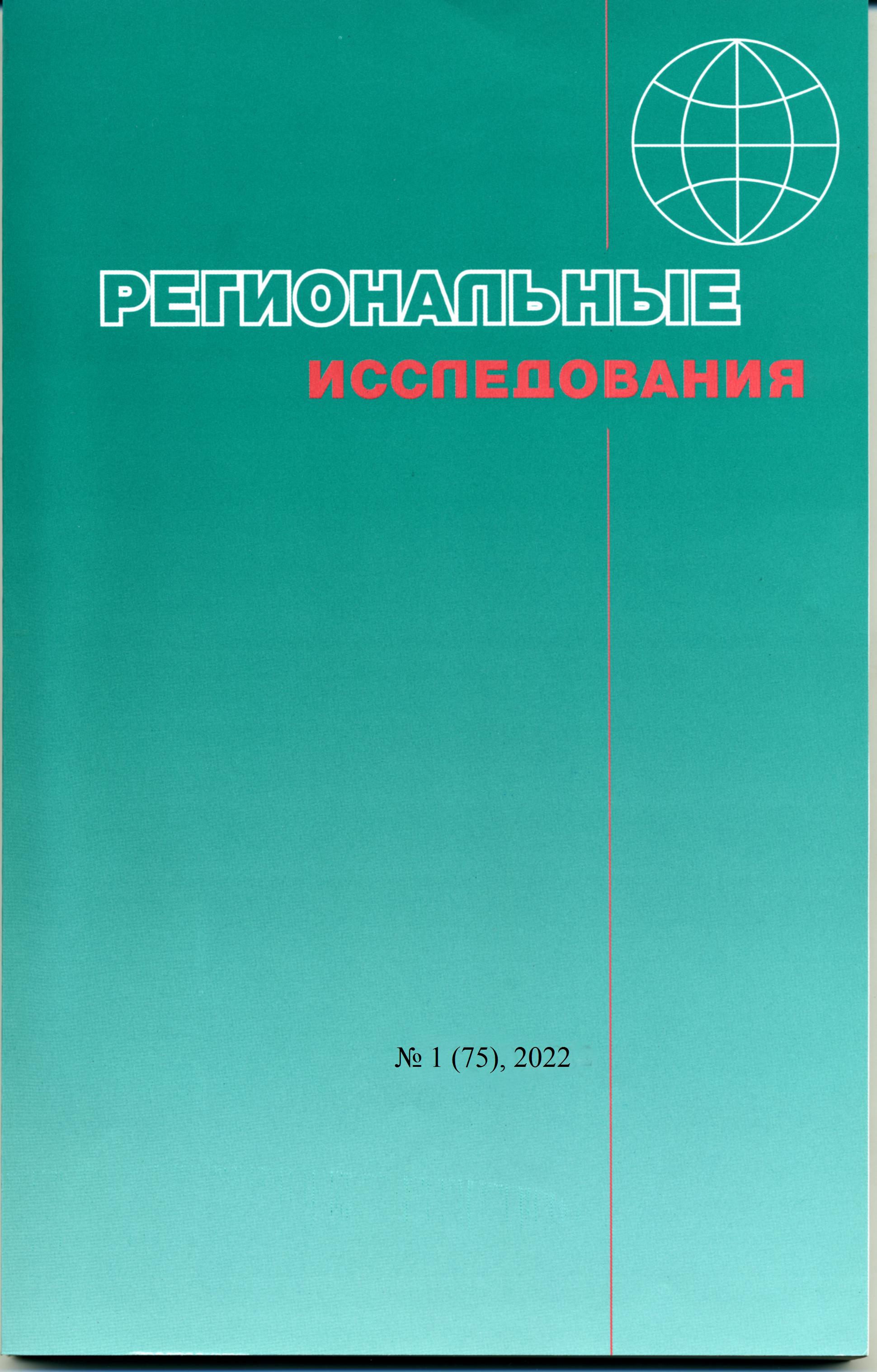Gres R.A., Zhikharevich B.S., Pribyshin T.K. Agglomeration scenarios in the planning strategies of the Leningrad region municipalities
DOI:
https://doi.org/10.5922/1994-5280-2022-1-7Keywords:
Socio-economic development strategy, agglomeration, municipality, rural settlement, urban settlement, municipal district, Leningrad regionAbstract
The purpose of the study is to measure the level of «agglomeration» of municipal strategies of the Leningrad region, that is, the depth of reflection in the context of the strategy of understanding the significance of inclusion in the composition or being in the zone of influence of the St. Petersburg agglomeration. The study has been conducted on the example of municipal districts and settlements of the Leningrad region. A list of eight «agglomeration strategies» and a method of expert scoring evaluation of the manifestation of each scenario in the strategy text have been developed. A threecomponent methodology for assessing the degree of «agglomeration» of the strategy has been implemented. The results show that the «agglomeration» of the strategy lessen with increasing distance from St. Petersburg. Nevertheless, the strategy of the Kirovsky district, which is part of the agglomeration, received the maximum assessment. This can be explained by the fact that the «agglomeration» of strategies also depends on the consultants involved in the development of strategies. Municipal strategies of the Leningrad Region were created with the participation of such organizations as Urbanica, RegionExpo, Higher School of Economics and ENKO. Among the eight identified «agglomeration strategies», «Industrial connectivity», «Demography and mobility» and «Transport connectivity» appeared to be more common and better worked out. The scenarios «Infrastructure and Finance» and «Ecology» are less frequent and manifested worse. «Agglomeration» has a predominantly positive connotation in the strategies of the districts close to St. Petersburg, while the connotation in the strategies of the peripheral districts of the region is mostly negative. When updating municipal strategies of the Leningrad region, it is recommended to increase the degree of integrity of the «agglomeration strategies» consideration; take into account forecasts concerning the dynamics of the St. Petersburg agglomeration boundaries and synchronize the development of strategies at different levels.
References
Жихаревич Б.С., Прибышин Т.К. Стратегии развития городов: российская практика 2014–2019 гг. // Пространственная экономика, 2019. Т. 15. № 4. С. 184–204.
Кабанов В.Н., Михайлова Е.В. Агломерация сельских поселений как стратегия социальноэкономического развития территорий // Региональная экономика: теория и практика. 2018. Т. 16. № 11. С. 2092–2107.
Климанов В.В. и др. Региональное стратегирование, прогнозирование и программирование в Российской Федерации 2017. М.: Ин-т реформирования обществ. финансов, 2018. 98 с.
Лаппо Г.М. Экономико-географические проблемы развития крупных городских агломераций СССР: дисс. … докт. геогр. наук: 11.00.02 / Ин-т географии АН СССР. М., 1975. 310 с.
Лосин Л.А., Солодилов В.В., Ляпунова Г.П. Административно-территориальные преобразования и формирование локальных центров расселения на территории Санкт-Петербургской городской агломерации // Экономика Северо-Запада: проблемы и перспективы развития. 2020. № 2–3. С. 33–46.
Монастырская М.Е., Песляк О.А. Методика определения границ городских агломераций // Вестн. БГТУ им. В.Г. Шухова. 2019. № 1. С. 111–121.
Мусинова Н.Н. Социально-экономическое развитие муниципальных образований в рамках городских агломераций // Вестн. ун-та: Актуальные вопросы управления, 2021. № 5. С. 5–11.
Анализ современных представлений о полицентрической структуре города // Вестн. Томск. гос. архит.-строит. ун-та. 2016. № 1 (54). С. 67–79.
Попов В.А. Стратегии совершенствования транспортной инфраструктуры как важнейшего фактора полицентрического развития Санкт-Петербургской агломерации // Современные проблемы науки и образования. 2013. № 5.С. 396–403.
Радченко Д.M., Пономарев Ю. Разработка научно-методологических подходов к идентификации фактических границ агломераций в России с учетом пространственного распределения экономической активности. М.: ФГБОУ ВО РАНХиГС, 2020. 65 с.
Ходачек А.М. О петербургской агломерации на основе концепции градостроительного развития // Экономика Северо-Запада: проблемы и перспективы развития. 2017. № 1. С. 35–47.
Основные положения Концепции совместного градостроительного развития Санкт-Петербурга и территорий Ленинградской области (агломерации) на период до 2030 года и с перспективой до 2050 года. Санкт-Петербург, 2018. 45 с.
Стратегия пространственного развития Российской Федерации на период до 2025 года. Утв. распоряжением Правительства Российской Федерации от 13 февраля 2019 г. № 207-р. М., 2019. 116 с.
Стратегия социально-экономического развития Кировского муниципального района Ленинградской области на период до 2030 года / Утверждена решением Совета депутатов от 22.11.2017 № 92. СПб, 2017. 219 с.
Стратегия социально-экономического развития муниципального образования Ропшинское сельское поселение Ломоносовского муниципального района Ленинградской области на период до 2025 г. / Утверждена решением Совета депутатов от 26.03.2015 № 11. 113 с.
Стратегия социально-экономического развития муниципального образования «Город Пикалево» Бокситогорского района Ленинградской области на период до 2030 г. / Утверждена решением Совета депутатов МО «Город Пикалево» от 24.11.2020 г. № 74. 105 с.
Стратегия социально-экономического развития Пермского муниципального района на 2016–2030 гг. / Утверждена решением Земского Собрания от 28.04.2015 № 60. Пермь, 2016. 132 с.
Стратегия социально-экономического развития Сланцевского городского поселения Сланцевского муниципального района Ленинградской области на период до 2025 года / Утверждена решением Совета депутатов от 25.10.2017 № 377-рсд, 87 с.
Территориальное стратегическое планирование при переходе к рыночной экономике: опыт городов России. СПб: ГП МЦСЭИ «Леонтьевский центр», 2003. 384 с.
Rahayu H., Haigh R., Amaratunga D. Strategic challenges in development planning for Denpasar City and the coastal urban agglomeration of Sarbagita // Procedia Engineering. 2018. № 212. P. 1347–1354.
Schmitt P. Managing urban change in five European urban agglomerations: key policy documents and institutional frameworks //Eraydin A., Taşan-Kok T. (eds.) Resilience Thinking in Urban Planning // GeoJournal Library, 2013. Vol. 106. Springer, Dordrecht. P. 109–130.

